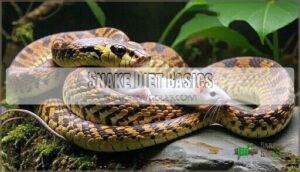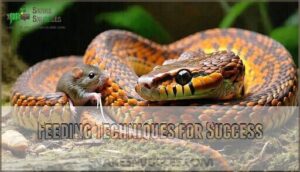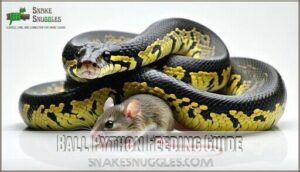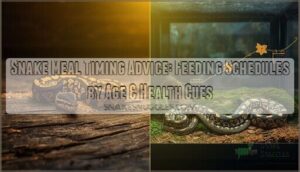This site is supported by our readers. We may earn a commission, at no cost to you, if you purchase through links.

You’ll want to use frozen-thawed rodents rather than live prey for safety reasons. Thaw completely to room temperature, then offer using feeding tongs in a quiet, dimly lit space.
Most adult snakes eat every 1-2 weeks, while juveniles need food more frequently.
The key is patience – snakes can be picky eaters, and forcing the issue rarely works. Your snake’s hunting instincts will kick in when conditions feel right, but there are proven tricks to encourage reluctant feeders that can make all the difference.
Table Of Contents
- Key Takeaways
- How to Feed a Snake Whole Food Prey?
- Snake Diet Basics
- Feeding Constrictor Snakes
- Feeding Frequency and Water
- Understanding Snake Species’ Needs
- Reducing Stress for Successful Feeding
- Feeding Techniques for Success
- Ball Python Feeding Guide
- Supplements and Safety
- Troubleshooting Feeding Issues
- Frequently Asked Questions (FAQs)
- Conclusion
Key Takeaways
- Choose the right prey size – You’ll want to match prey width to your snake’s thickest body section to prevent regurgitation and ensure safe swallowing.
- Use frozen-thawed prey for safety – You should avoid live prey that can injure your snake and stick with safer frozen-thawed rodents that you’ve properly thawed to room temperature.
- Feed on the right schedule – You’ll need to feed juveniles weekly, while adults can go 10-14 days between meals, depending on your snake’s species and size.
- Create stress-free feeding conditions – You should maintain quiet environments, use feeding tongs, and be patient with picky eaters, since forcing feeding rarely works.
How to Feed a Snake Whole Food Prey?
Feeding your snake whole prey starts with proper frozen-thawed rodents – never feed live prey that can injure your pet.
Begin prey thawing by moving frozen mice or rats from freezer to refrigerator overnight, then warm in sealed bags using room temperature water.
Use feeding tongs to safely offer prey, avoiding hand-feeding that creates dangerous associations.
Whole prey feeding provides complete nutrition without supplements, unlike incomplete meals that lack essential nutrients.
Place thawed prey in your snake’s enclosure and allow natural feeding behavior – they’ll strike and swallow whole.
Most snakes eat every 1-2 weeks depending on size and species.
Keep feeding sessions stress-free by maintaining quiet environments and avoiding handling immediately after meals to prevent regurgitation.
Snake Diet Basics
Before you start feeding your snake, you need to understand that all snakes are strict carnivores who can’t digest plant matter and must eat whole animals to survive.
Your snake’s specific dietary needs depend entirely on its species, size, and age—what works for a ball python won’t necessarily work for a corn snake.
All Snakes Are Carnivores
Understanding carnivores starts with knowing every snake’s nutritional needs center on protein.
Your snake’s wild diets varied dramatically—some hunted rodents while others targeted insects or fish.
In captivity, feeding snakes means respecting this dietary diversity. Snake nutrition demands whole prey because that’s how nature designed them.
Whether it’s mice, birds, or amphibians, snake diet success depends on matching their carnivorous blueprint.
Snakes often utilize ambush and stealth to capture their prey.
Diet Depends on Species
While all snakes are carnivores, their prey preferences vary dramatically by species.
Your snake’s dietary needs depend entirely on what type you’re caring for, making species diet variety research absolutely critical.
Different snake species have evolved specialized diets:
- Rodent specialists like ball pythons and corn snakes thrive on mice and rats
- Fish eaters such as garter snakes prefer aquatic prey and amphibians
- Egg specialists like African egg-eating snakes consume only bird eggs
Understanding your snake’s natural prey preferences guarantees proper nutrition and feeding success.
Swallowing Food Whole
Watching a snake consume prey that’s twice the size of its head seems impossible, yet snakes master this feat through remarkable jaw flexibility.
Nature’s ultimate swallowing trick: snakes unhinge their jaws to devour prey twice their head size.
Their lower jaw can unhinge and stretch dramatically, while flexible ligaments allow their skull bones to separate slightly.
This incredible snake feeding adaptation lets them swallow whole prey much larger than their head circumference.
Whole
Prey
Understanding proper prey size prevents regurgitation risks and guarantees smooth digestion process.
The nutritional benefits of whole prey feeding provide complete nutrition, unlike processed foods.
Your snake’s digestive system handles entire animals efficiently, breaking down bones, organs, and tissue.
These snake feeding techniques replicate natural snake diet patterns, supporting peak health through proper snake digestion.
Feeding Constrictor Snakes
Constrictor snakes like boas and pythons thrive on whole prey items such as mice, rats, and small birds that provide complete nutrition.
You’ll want to avoid live prey since it can injure your snake and stick with safer frozen-thawed options instead.
Typical Prey for Constrictors
Constrictors are nature’s ultimate opportunists in the context of mealtime. These powerful predators have evolved to tackle diverse prey, making them incredibly adaptable hunters in both wild and captive settings.
Your constrictor’s menu includes:
- Rodent varieties – Frozen mice, rats, and gerbils provide excellent nutritional value and are easily sourced
- Bird options – Chicks, quail, and small birds offer dietary diversity for larger constrictors
- Prey size matters – Match prey width to your snake’s thickest body section for safe swallowing
- Whole prey benefits – Complete nutrition from bones, organs, and tissues eliminates supplement needs
- Frozen-thawed prey – Safer than live options while maintaining nutritional integrity for your snake
Boa constrictors thrive on a diet of whole animal prey.
Importance of Whole Prey
Feeding whole prey isn’t just convenient—it’s like giving your snake a complete diet straight from nature’s playbook.
When your constrictor consumes an entire mouse or rat, they’re getting complete nutrition that includes muscle, organs, and bones in perfect proportions.
This natural diet delivers essential calcium for bone health and supports ideal digestion benefits.
Unlike processed foods that often fall short, whole prey provides a protein-rich diet that eliminates reduced deficiencies commonly seen in captive snakes.
The nutritional completeness of this approach means you won’t need supplements—your snake gets everything from this nutritious snake food.
It’s nature’s way of ensuring your pet thrives.
Avoiding Live Prey
Your snake’s health matters more than convenience.
Live prey poses serious Live Prey Risks that Frozen Prey Benefits eliminate:
- Injury Prevention: Live rodents bite and scratch, potentially causing infections
- Ethical Considerations: Frozen prey offers Humane Alternatives without suffering
- Parasite Protection: Thawed prey reduces disease transmission risks
Safe snake feeding means choosing frozen prey over live options for your pet’s wellbeing.
Feeding Frequency and Water
Getting your snake’s feeding schedule right depends on their age, species, and size—younger snakes typically need meals every 5-7 days while adults can go 10-14 days between feedings.
You’ll also need to keep fresh, clean water available at all times in a heavy ceramic bowl that won’t tip over easily, ensuring a stable and clean environment.
Factors Affecting Feeding Frequency
Several key factors determine your snake’s feeding frequency and schedule. Understanding these elements helps you create the right feeding habits for your pet’s specific needs.
Factors that shape your snake’s appetite:
- Snakes age matters – Young snakes burn energy faster and need weekly meals, while adults can wait 10-14 days
- Activity level influences hunger – Active snakes require more frequent feeding than couch potato serpents
- Breeding season changes everything – Females preparing to reproduce need extra nutrition and calories
- Species needs vary dramatically – Ball pythons eat differently than corn snakes or boas
- Health status affects appetite – Sick or stressed snakes may refuse food entirely
Your snake’s individual personality also plays a role. You can find ball python food online. Some are enthusiastic eaters who never miss a meal, while others are pickier than a toddler at dinnertime.
Monitor your snake’s body condition and adjust the snake feeding schedule accordingly. A well-fed snake should have a rounded body without visible ribs or a protruding spine.
Providing Fresh, Clean Water
Water isn’t just about quenching thirst—it’s your snake’s lifeline for proper digestion and shedding.
Choose a heavy ceramic bowl that won’t tip when your snake decides to take a dip. Fresh water daily keeps bacteria at bay and supports ideal hydration signs like bright eyes and smooth skin.
Snakes rely on capillary action to efficiently hydrate.
Here are key water essentials for snake wellbeing:
- Water bowl size: Should accommodate your snake’s body length
- Water source options: Use dechlorinated tap water or distilled water
- Hydration signs: Watch for clear eyes and elastic skin
- Shedding and water: Increase humidity levels during shed cycles
- Snake feeding hydration: Always provide water after meals
Water Bowl Maintenance
Keeping your water bowl maintenance routine consistent guarantees maximal snake hydration and environment health.
Choose a heavy ceramic bowl that’s large enough for soaking—your snake will appreciate the extra room. Bowl placement matters; position it away from bedding to maintain water quality.
Clean daily by scrubbing, disinfecting, and rinsing thoroughly. Fresh water prevents bacterial growth and supports proper humidity control.
Bowl size should accommodate your snake’s need for both drinking and occasional soaking, contributing to overall snake feeding hydration success. Using a durable feeding container can also prevent messes, ensuring a healthy environment for your snake and supporting proper humidity control.
Understanding Snake Species’ Needs
Every snake species has unique dietary preferences that you’ll need to research before choosing prey.
While most snakes eat rodents, some prefer specific colors, sizes, or even different types of prey like birds or fish, so understanding your snake’s natural habits will help you provide the best nutrition possible, which includes researching their dietary preferences.
Researching Specific Dietary Needs
Understanding your snake’s dietary needs starts with thorough Species Diet Research. Each species has evolved to thrive on specific prey types, and mimicking their Wild Diet reduces Nutritional Deficiencies substantially.
Before bringing home your scaly companion, research their natural feeding habits. Some snakes switch prey preferences as they mature – young colubrids might prefer lizards before shifting to rodents as adults.
Here’s what to investigate for proper snake feeding dietary needs:
- Natural prey species your snake would hunt in the wild
- Prey Variety requirements and seasonal feeding changes
- Size Appropriateness guidelines for different life stages
- Nutritional needs specific to your snake species
- Feeding frequency patterns based on age and metabolism
This research prevents common feeding mistakes and helps your whole prey selections support healthy snake feeding nutrition throughout their lifetime. Veterinarians often advise using pre-killed prey to avoid injuries.
Adapting to Changes in Diet
Your snake’s tastes might shift dramatically as it grows—like a teenager discovering sushi after years of chicken nuggets.
Many species experience significant dietary shifts throughout their lives, creating unique feeding challenges for owners. Young colubrids often start with lizards before switching to rodents, while some pythons develop new food aversions seemingly overnight.
These changes aren’t always predictable, but understanding refusal reasons helps you adapt your approach. When implementing dietary shifts, patience becomes your best friend:
- Start with gradual changeover periods: Mix familiar scents with new prey items to ease acceptance
- Monitor feeding responses closely: Watch for stress signals that indicate the change is too rapid
- Consider supplement introduction timing: New diets may require nutritional adjustments during the switch
Successful adaptation means reading your snake’s cues and adjusting accordingly. Some picky eaters need weeks to accept changes, while others adapt within days. You can find products designed to help with this dietary change.
Considering Color and Prey Preferences
Believe it or not, prey color matters more than you’d think.
Your snake might turn its nose up at a bright white mouse if it’s used to darker preferred prey. Snake feeding preferences can be surprisingly picky about color and appearance.
Try scenting techniques or adjust lighting effects during feeding time.
Some snakes prefer brown or gray whole prey that matches their wild diet.
Pay attention to your snake’s taste preferences – they’ll show you what works best for successful snake feeding.
Reducing Stress for Successful Feeding
When your snake won’t eat, stress might be the culprit that’s making mealtime a nightmare.
Creating the right environment and trying different prey options can turn your picky eater into a satisfied serpent.
Identifying and Reducing Stress Factors
Beyond handling techniques and enclosure security, stress factors can sabotage your snake’s appetite completely.
When shedding stress peaks or temperature control falters, even the hungriest python might refuse food.
Here’s how to create stress-free feeding conditions:
- Minimize handling – Skip unnecessary interactions during feeding cycles
- Monitor lighting impact – Reduce bright lights that trigger defensive responses
- Maintain stable temperatures – Fluctuations disrupt natural feeding rhythms
Consistent feeding environment practices help reduce snake stress substantially.
Creating a Comfortable Environment
Your snake’s home should feel like a safe haven, not a stress zone. Temperature gradients between 75-95°F and proper humidity levels create comfort.
Choose appropriate substrate choice and enclosure size for your species. Multiple hiding spots on both warm and cool sides reduce anxiety.
A calm feeding environment with minimal disturbances promotes stress-free feeding.
| Environment Factor | Ideal Range | Impact on Feeding |
|---|---|---|
| Temperature | 75-95°F gradient | Proper digestion |
| Humidity | Species-specific 40-80% | Prevents dehydration |
| Hiding spots | 2+ per enclosure | Reduces anxiety |
| Lighting | Low/indirect during feeding | Mimics natural behavior |
| Noise level | Minimal disturbance | Prevents feeding refusal |
Experimenting With Prey Options
When your snake turns its nose up at dinner, it’s time to play matchmaker between your pet and potential prey options. Think of it as a culinary adventure where you’re the chef discovering what makes your snake’s taste buds sing.
Alternative prey options can make all the difference for picky eaters. Start by experimenting with different species, colors, and sizes to find your snake’s preference:
- White vs. brown mice – Some snakes show strong color preferences
- Rats vs. mice – Switch between species if one isn’t working
- Different prey size options – Try smaller or larger within safe ranges
- Fresh vs. aged frozen – Some snakes prefer slightly "aged" frozen prey
Scenting techniques work wonders too. Rub the prey with chicken broth or even lizard scent to trigger feeding responses. Remember, live vs frozen prey preferences vary by individual snake. Dietary variety supports nutritional balance while keeping your snake interested in whole prey meals.
Feeding Techniques for Success
Successfully feeding your snake doesn’t have to be complicated, but using the right techniques can make all the difference between a smooth meal and a stressful standoff.
These proven methods will help encourage even picky eaters to accept their prey while keeping both you and your snake safe during feeding time, which is crucial for a stressful standoff to be avoided.
Nocturnal Feeding and Dark Containers
Since many snakes are naturally Nighttime Hunting creatures, timing your feeding sessions can make all the difference in success rates.
Most species feel more comfortable eating when the lights are dim, mimicking their Natural Behavior patterns in the wild. Using Dark Enclosures or a dedicated feeding container creates an environment where your snake feels secure and focused on the prey.
Here are some key benefits of nocturnal feeding and using dark containers:
- Prey Safety: By feeding at night in a controlled environment, you reduce the risk of prey escaping and causing stress to your snake.
- Snake Stress: Nocturnal feeding can help reduce stress on your snake, as it mimics their natural hunting behaviour.
- Feeding Schedule: Feeding your snake in the evening can become part of a consistent routine, helping to regulate their feeding schedule.
This approach works particularly well with frozen whole prey, as Reduced Lighting helps trigger the snake’s natural Feeding Response without the complications of live prey movement.
Stimulating Feeding With Misting and Teasing
Picture a gentle rainfall awakening your snake’s hunting instincts.
Misting your snake with warm water creates sensory stimulation that mimics natural humidity changes, triggering their feeding behavior.
Teasing techniques like gently moving prey items simulate live movement, enhancing prey presentation.
These feeding techniques provide behavioral enrichment while addressing common feeding challenges through natural snake feeding tips.
Scenting Prey Items for Success
Scenting prey items can be a game-changer for picky eaters.
If your snake turns its nose up at regular mice, try rubbing the prey with different scents to trigger its hunting instincts. This simple feeding technique transforms reluctant feeders into enthusiastic diners.
Scenting prey mimics natural odors, enticing picky eaters.
- Lizard rubbing: Rub thawed prey with a gecko or anole for two minutes to transfer natural scent glands
- Chicken broth: Lightly brush prey with warm broth to add appealing poultry aroma
- Brain puncturing: Make small holes in prey’s skull to release attractive scents that draw strikes
- Feeder variety: Experiment with different scenting materials like fish oil, eggs, or bird feathers until you find what works
Ball Python Feeding Guide
Ball pythons are popular pets that thrive on a diet of appropriately sized rodents, making feeding straightforward once you understand their specific needs.
You’ll find success by matching prey size to your python’s girth and establishing a consistent feeding routine that keeps your snake healthy and stress-free.
What Do Ball Pythons Eat?
Ball pythons are carnivores with straightforward nutritional needs.
Snakes are nature’s perfect predators – their straightforward carnivorous design makes feeding surprisingly simple once you understand the basics.
They thrive on whole prey like mice and rats, which provide complete nutrition. Understanding your ball python’s feeding requirements helps guarantee healthy growth and development.
Here’s what matters most when feeding ball pythons:
- Prey size should match your snake’s thickest body section – too large causes regurgitation, too small leaves them hungry
- Frozen vs. live prey both work, though frozen prey thawing offers safer, more convenient feeding without injury risks
- Feeding frequency depends on age – juveniles eat weekly while adults feed every 10-14 days based on their slower metabolism
Prey Size and Variety
Choosing the right prey size for your ball python isn’t rocket science, but it makes all the difference. Your snake’s meal should match the thickest part of its body—no bigger. This Appropriate Size rule prevents choking and guarantees comfortable digestion.
| Snake Age | Feeder Types |
|---|---|
| Hatchling | Pinkie mice |
| Juvenile | Fuzzy mice |
| Young Adult | Adult mice |
| Large Adult | Small rats |
| Extra Large | Medium rats |
Dietary Variety matters too. Rotating between mice and rats provides Nutritional Completeness while preventing your snake from becoming a picky eater. Stick to whole prey for balanced nutrition—it’s nature’s perfect package deal. Watch for Overfeeding Risks by maintaining proper prey size ratios.
Feeding Chart and Tips
Following your chart’s Prey Size recommendations, feed hatchlings every 5 days with prey around 10% of their body weight.
Your Feeding Schedule should adjust as they grow – juveniles can wait 4-6 weeks between meals.
This snake feeding guide keeps your Feeding Chart simple: smaller snakes eat more often, bigger ones need patience.
Thawing Methods and proper Warming Techniques help guarantee success when Handling Prey during whole prey feeding sessions.
Supplements and Safety
When you’re feeding your snake whole prey, you’re providing complete nutrition that eliminates the need for most supplements.
However, proper handling and storage of prey items is essential for your snake’s health and your own safety.
Whole Prey Nutrition and Supplements
Whole prey delivers nutritional completeness your snake needs—no guesswork required.
These protein-rich diet staples contain perfect calcium ratios and support ideal digestion benefits.
Prey variety like mice, rats, and chicks naturally provides balanced nutrition.
Vitamin supplementation isn’t necessary when feeding varied whole food prey.
Skip routine supplements—your snake’s getting everything from nature’s perfect package.
Ensuring proper digestion also requires proper temperature gradients.
Safe Handling and Storage of Prey
Proper safe handling and frozen prey storage can make or break your snake’s health. You wouldn’t eat spoiled food, and neither should your snake.
Key Storage and Handling Guidelines:
- Frozen storage duration: Keep prey frozen for up to 12 months maximum for ideal freshness
- Thawing methods: Use refrigerator overnight, then warm water bath to prevent bacteria growth
- Bacteria prevention: Always use clean tongs and wash hands before handling frozenthawed rodents
- Injury risks: Never refreeze thawed prey as it compromises texture and creates harmful bacteria
Store your snake storage freezer separately from human food. Thawed prey should feel slightly warm to touch, mimicking natural body temperature. If prey smells off or feels slimy, toss it immediately. Your snake’s nose knows quality better than yours.
Avoiding Incomplete Meals and Refused Prey
Whole prey nutrition means avoiding shortcuts that compromise your snake’s health.
Never offer incomplete meals like meat scraps—they lack essential nutrients and cause digestive issues.
When your snake refuses food, remove and discard the prey immediately.
Refreezing creates bacteria that trigger feeding refusal and nutritional deficiencies.
Proper handling prevents these snake feeding issues completely.
Troubleshooting Feeding Issues
Even the most experienced snake owners face feeding challenges from time to time.
Whether your snake refuses meals or shows unusual eating behaviors, these troubleshooting strategies will help you get back on track.
Encouraging Feeding in Picky Snakes
Dealing with snake feeding refusal can feel like solving a puzzle, but don’t worry—you’ve got plenty of tricks up your sleeve. Picky eaters are more common than you’d think, and with the right approach, you’ll have your snake back to regular meals.
Scenting techniques work wonders for stubborn feeders. Try rubbing prey with a previously eaten item or using commercial scenting products. Some keepers swear by puncturing the prey’s brain to release natural scents that trigger feeding responses.
Temperature tweaking and lighting adjustments can make all the difference. Offer food during your snake’s natural feeding time—usually evening or night. Privacy feeding helps too; cover the enclosure or move your snake to a quiet feeding box.
Here are three proven methods for encouraging reluctant eaters:
- Gradual changes: Switch prey types slowly, mixing familiar and new options
- Movement simulation: Use feeding tongs to create lifelike prey motion
- Environmental modifications: Adjust humidity, hide boxes, or feeding locations
Remember, troubleshooting feeding issues requires patience. Your snake isn’t being difficult on purpose—they’re just following their instincts.
Addressing Feeding Challenges and Concerns
You’re not alone if your snake gives you the cold shoulder at mealtime. Snake feeding challenges happen to even experienced keepers, but most issues have straightforward solutions.
Here’s how to tackle the most common problems:
- Picky eaters: Try different prey sizes, colors, or scenting techniques. Some snakes prefer their food warmed to specific temperatures or need complete darkness while eating.
- Regurgitation causes: This serious issue often stems from handling too soon after feeding, incorrect temperatures, or oversized prey. Wait at least 48 hours before handling and make certain proper prey sizing.
- Obesity risks: Overfeeding leads to health problems. Stick to appropriate feeding schedules – adults typically eat every 10-14 days, not weekly like juveniles.
- Live prey concerns: While some snakes seem to prefer live prey, frozen-thawed options reduce injury risks and supplement concerns. Gradually switch stubborn eaters by offering freshly killed prey first.
Remember, troubleshooting feeding issues takes patience and observation of your snake’s specific preferences.
When to Consult a Veterinarian
Sometimes even your best troubleshooting efforts hit a wall, and that’s when professional help becomes your lifeline.
Don’t hesitate to contact a reptile veterinarian when you notice these red flags:
- Sudden Refusal to eat for more than 4-6 weeks, especially if accompanied by weight loss or lethargy
- Regurgitation Issues happening repeatedly after meals, which could signal digestive problems
- Abnormal Shedding patterns or stuck shed around the mouth area affecting feeding ability
- Parasite Concerns like visible worms, unusual feces, or unexplained weight loss despite regular eating
A qualified snake feeding veterinarian can diagnose underlying snake health problems that aren’t obvious to owners.
They’ll assess snake digestive issues, recommend treatments, and help you develop a feeding plan that works.
Remember, catching snake health complications early often means simpler, less expensive solutions.
Frequently Asked Questions (FAQs)
How do you feed a snake?
Like feeding a hungry dragon, you’ll offer your snake frozen-thawed prey using feeding tongs.
Choose appropriately sized rodents, warm them to body temperature, and present them confidently to trigger your snake’s natural hunting response, which is similar to feeding a hungry dragon.
This will help to trigger your snake’s hunting instinct.
What do pet snakes eat?
Pet snakes eat whole prey like mice, rats, and small birds.
You’ll feed frozen-thawed rodents that match your snake’s body width.
Most species need feeding every 5-14 days depending on age and size.
How much should a snake eat?
Your snake should eat prey that’s roughly the same width as the thickest part of its body.
This "one lump, no bump" rule prevents regurgitation and guarantees safe digestion while providing complete nutrition.
Do snakes eat whole animals?
Yes, snakes swallow their prey whole due to their incredibly flexible jaws that can dislocate to accommodate animals much larger than their head diameter.
You’ll find that whole prey provides complete nutrition, including bones, organs, and muscle tissue essential for proper calcium-phosphorus ratios and overall health.
Do snakes need a lot of food?
No, snakes don’t need a lot of food.
They’re incredibly efficient eaters who consume whole prey infrequently – juveniles eat weekly, while adults can go 10-14 days between meals.
Making them surprisingly low-maintenance pets, as they are incredibly efficient eaters.
What do snakes eat in captivity?
Over 95% of captive snakes thrive on frozen-thawed rodents. You’ll feed your snake whole prey like mice or rats, matching the prey size to your snake’s body width for proper digestion.
How do snakes eat prey whole?
Your snake’s flexible jaw joints unhinge, allowing their mouth to stretch incredibly wide.
They use backward-curved teeth to grip prey, then use muscular contractions to slowly push the meal down their throat into their stomach, utilizing their muscular contractions.
What is the best way to feed a snake?
Perfect preparation starts with selecting frozen-thawed prey that matches your snake’s body width. Thaw overnight in the refrigerator, warm in water to body temperature, then offer using feeding tongs.
Can I feed my snake raw meat?
Raw meat isn’t recommended for snakes.
They need whole prey (mice, rats) that provides complete nutrition including bones, organs, and proper calcium ratios.
Raw meat lacks essential nutrients and can cause serious health issues.
What not to do when feeding a snake?
Don’t turn mealtime into a wrestling match!
Avoid handling snakes after feeding—they’ll regurgitate faster than you can say "oops."
Skip live prey that fights back, oversized meals, and leaving uneaten food around, to ensure a safe and healthy environment for your snakes, and avoid any potential risks.
Conclusion
Mastering how to feed a snake whole food prey transforms you from a nervous beginner into a confident keeper.
You’ve learned the essentials: proper sizing, frozen-thawed safety, species-specific needs, and stress reduction techniques.
Remember that patience wins with picky eaters—your snake’s natural instincts will guide successful feeding when you create the right conditions.
With consistent practice and attention to your snake’s unique preferences, feeding time becomes routine rather than stressful for both of you.
- https://www.reddit.com/r/snakes/comments/2q585m/why_do_captive_snakes_need_to_eat_whole_prey/
- https://nationalzoo.si.edu/animals/corn-snake
- https://www.allbirds.com/collections/little-kids
- https://lafeber.com/vet/basic-information-boas-and-pythons/
- https://www.thesprucepets.com/what-size-prey-should-i-feed-my-pet-snake-1239478



















